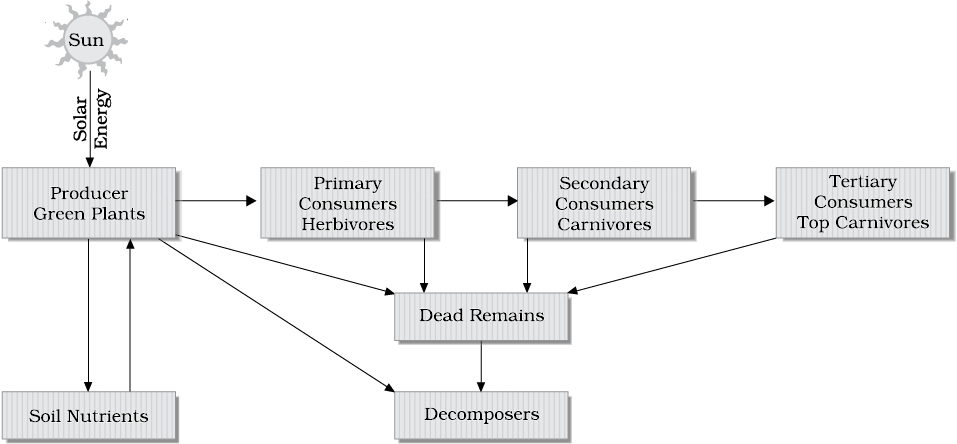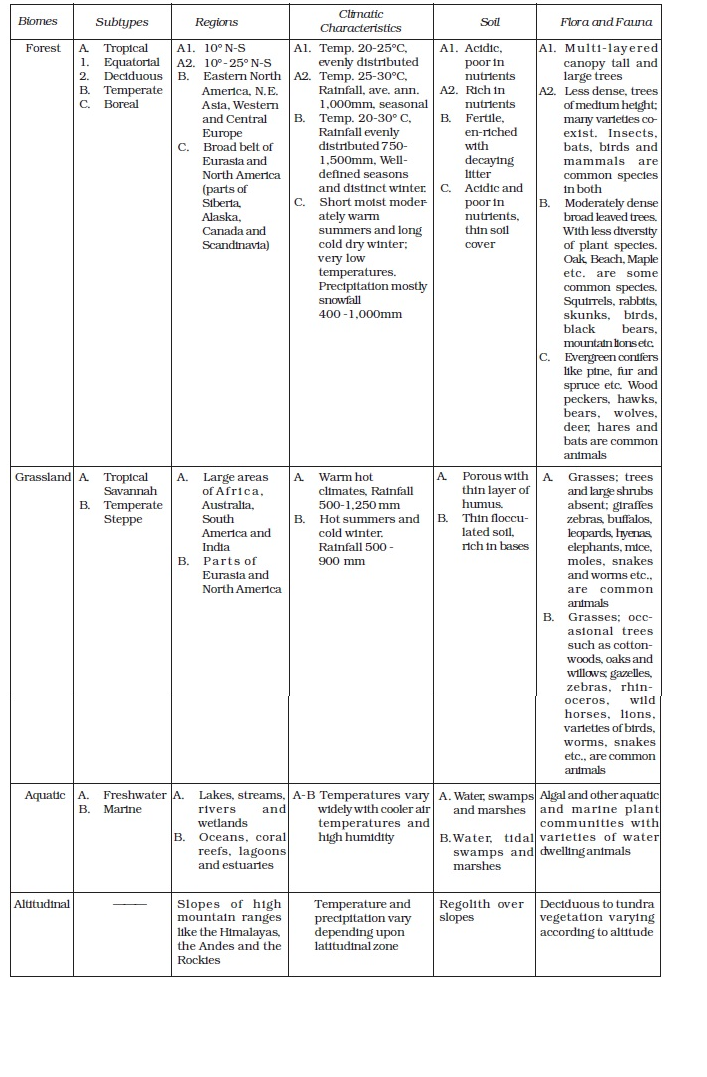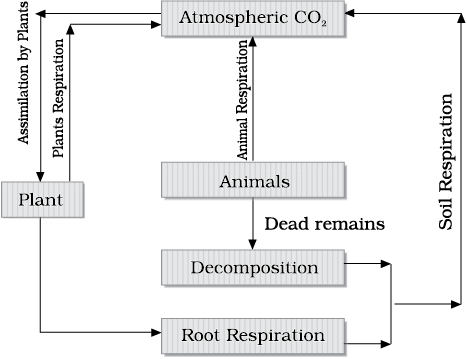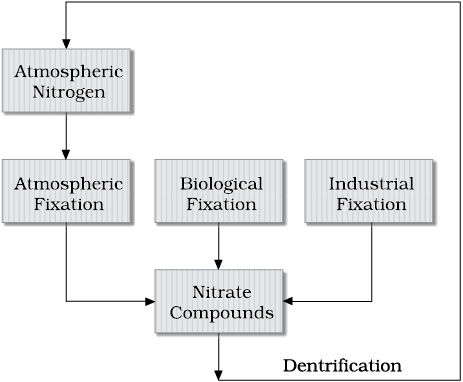Table of Contents
Unit VI
Life on the Earth
This unit deals with
- Biosphere — importance of plants and other organisms; ecosystems, bio-geo chemical cycle and ecological balance; biodiversity and conservation

CHAPTER 15
Life on the Earth
By now you might have realised that all units of this book have acquainted you with the three major realms of the environment, that is, the lithosphere, the atmosphere and the hydrosphere. You know that living organisms of the earth, constituting the biosphere, interact with other environmental realms. The biosphere includes all the living components of the earth. It consists of all plants and animals, including all the micro-organisms that live on the planet earth and their interactions with the surrounding environment. Most of the organisms exist on the lithosphere and/or the hydrosphere as well as in the atmosphere. There are also many organisms that move freely from one realm to the other.
Life on the earth is found almost everywhere. Living organisms are found from the poles to the equator, from the bottom of the sea to several km in the air, from freezing waters to dry valleys, from under the sea to underground water lying below the earth’s surface.
The biosphere and its components are very significant elements of the environment. These elements interact with other components of the natural landscape such as land, water and soil. They are also influenced by the atmospheric elements such as the temperature, rainfall, moisture and sunlight. The interactions of biosphere with land, air and water are important to the growth, development and evolution of the organism.
Ecology
You have been reading about ecological and environmental problems in newspapers and magazines. Have you ever thought what ecology is? The environment as you know, is made up of abiotic and biotic components. It would be interesting to understand how the diversity of life-forms is maintained to bring a kind of balance. This balance is maintained in a particular proportion so that a healthy interaction between the biotic and the abiotic components goes on.
The term ecology is derived from the Greek word ‘oikos’ meaning ‘house’, combined with the word ‘logy’ meaning the ‘science of’ or ‘the study of’. Literally, ecology is the study of the earth as a ‘household’, of plants, human beings, animals and micro-organisms. They all live together as interdependent components. A German zoologist Ernst Haeckel, who used the term as ‘oekologie’ in 1869, became the first person to use the term ‘ecology’. The study of interactions between life forms (biotic) and the physical environment (abiotic) is the science of ecology. Hence, ecology can be defined as a scientific study of the interactions of organisms with their physical environment and with each other.
The interactions of a particular group of organisms with abiotic factors within a particular habitat resulting in clearly defined energy flows and material cycles on land, water and air, are called ecological systems.
A habitat in the ecological sense is the totality of the physical and chemical factors that constitute the general environment. A system consisting of biotic and abiotic components is known as ecosystem. All these components in ecosystem are inter related and interact with each other. Different types of ecosystems exist with varying ranges of environmental conditions where various plants and animal species have got adapted through evolution. This phenomenon is known as ecological adaptation.
Types of Ecosystems
Ecosystems are of two major types: terrestrial and aquatic. Terrestrial ecosystem can be further be classified into ‘biomes’. A biome is a plant and animal community that covers a large geographical area. The boundaries of different biomes on land are determined mainly by climate. Therefore, a biome can be defined as the total assemblage of plant and animal species interacting within specific conditions. These include rainfall, temperature, humidity and soil conditions. Some of the major biomes of the world are: forest, grassland, desert and tundra biomes. Aquatic ecosystems can be classed as marine and freshwater ecosystems. Marine ecosystem includes the oceans, estuaries and coral reefs. Freshwater ecosystem includes lakes, ponds, streams, marshes and bogs.
Structure and Functions of Ecosystems
The structure of an ecosystem involves a description of the available plant and animal species. From a structural point of view, all ecosystems consist of abiotic and biotic factors. Abiotic factors include rainfall, temperature, sunlight, atmospheric humidity, soil conditions, inorganic substances (carbon dioxide, water, nitrogen, calcium, phosphorus, potassium, etc.). Biotic factors include the producers, the consumers (primary, secondary, tertiary) and the decomposers. The producers include all the green plants, which manufacture their own food through photosynthesis. The primary consumers include herbivorous animals like deer, goats, mice and all plant-eating animals. The carnivores include all the flesh-eating animals like snakes, tigers and lions. Certain carnivores that feed also on carnivores are known as top carnivores like hawks and mongooses. Decomposers are those that feed on dead organisms (for example, scavengers like vultures and crows), and further breaking down of the dead matter by other decomposing agents like bacteria and various micro-organisms.

Figure 15.1 : Structure and functions of ecosystems
The producers are consumed by the primary consumers whereas the primary consumers are, in turn, being eaten by the secondary consumers. Further, the secondary consumers are consumed by the tertiary consumers. The decomposers feed on the dead at each and every level. They change them into various substances such as nutrients, organic and inorganic salts essential for soil fertility. Organisms of an ecosystem are linked together through a foodchain (Figure 15.1). For example, a plant eating beetle feeding on a paddy stalk is eaten by a frog, which is, in turn, eaten by a snake, which is then consumed by a hawk. This sequence of eating and being eaten and the resultant transfer of energy from one level to another is known as the food-chain. Transfer of energy that occurs during the process of a foodchain from one level to another is known as flow of energy. However, food-chains are not isolated from one another. For example, a mouse feeding on grain may be eaten by different secondary consumers (carnivores) and these carnivores may be eaten by other different tertiary consumers (top carnivores). In such situations, each of the carnivores may consume more than one type of prey. As a result, the food- chains get interlocked with one another. This inter-connecting network of species is known as food web. Generally, two types of food-chains are recognised: grazing food-chain and detritus food-chain. In a grazing food-chain, the first level starts with plants as producers and ends with carnivores as consumers at the last level, with the herbivores being at the intermediate level. There is a loss of energy at each level which may be through respiration, excretion or decomposition. The levels involved in a food-chain range between three to five and energy is lost at each level. A detritus food-chain is based on autotrophs energy capture initiated by grazing animals and involves the decomposition or breaking down of organic wastes and dead matter derived from the grazing food-chain.
Types of Biomes
In the earlier paragraphs, you have learnt the meaning of the term ‘biome’. Let us now try to identify the major biomes of the world. There are five major biomes — forest, desert, grassland, aquatic and altitudinal biomes. Some features of these biomes are given in Table 15.1.
Biogeochemical Cycles
The sun is the basic source of energy on which all life depends. This energy initiates life processes in the biosphere through photosynthesis, the main source of food and energy for green plants. During photosynthesis, carbon dioxide is converted into organic compounds and oxygen. Out of the total solar insolation that reaches the earth’s surface, only a very small fraction (0.1 per cent) is fixed in photosynthesis. More than half is used for plant respiration and the remaining part is temporarily stored or is shifted to other portions of the plant.
Life on earth consists of a great variety of living organisms. These living organisms exist and survive in a diversity of associations. Such survival involves the presence of systemic flows such as flows of energy, water and nutrients. These flows show variations in different parts of the world, in different seasons of the year and under varying local circumstances. Studies have shown that for the last one billion years, the atmosphere and hydrosphere have been composed of approximately the same balance of chemical components. This balance of the chemical elements is maintained by a cyclic passage through the tissues of plants and animals. The cycle starts by absorbing the chemical elements by the organism and is returned to the air, water and soil through decomposition. These cycles are largely energised by solar insolation. These cyclic movements of chemical elements of the biosphere between the organism and the environment are referred to as biogeochemical cycles. Bio refers to living organisms and geo to rocks, soil, air and water of the earth.
There are two types of biogeochemical cycles : the gaseous and the sedimentary cycle. In the gaseous cycle, the main reservoir of nutrients is the atmosphere and the ocean. In the sedimentary cycle, the main reservoir is the soil and the sedimentary and other rocks of the earth’s crust.
The Water Cycle
All living organisms, the atmosphere and the lithosphere maintain between them a circulation of water in solid, liquid or gaseous form referred to as the water or hydrologic cycle (Chapter 13 of this book).
Table 15.1

The Carbon Cycle
Carbon is one of the basic elements of all living organisms. It forms the basic constituent of all the organic compounds. The biosphere contains over half a million carbon compounds in them. The carbon cycle is mainly the conversion of carbon dioxide. This conversion is initiated by the fixation of carbon dioxide from the atmosphere through photosynthesis. Such conversion results in the production of carbohydrate, glucose that may be converted to other organic compounds such as sucrose, starch, cellulose, etc. Here, some of the carbohydrates are utilised directly by the plant itself. During this process, more carbon dioxide is generated and is released through its leaves or roots during the day. The remaining carbohydrates not being utilised by the plant become part of the plant tissue. Plant tissues are either being eaten by the herbivorous animals or get decomposed by the micro-organisms. The herbivores convert some of the consumed carbohydrates into carbon dioxide for release into the air through respiration. The micro-organisms decompose the remaining carbohydrates after the animal dies. The carbohydrates that are decomposed by the micro-organisms then get oxidised into carbon dioxide and are returned to the atmosphere (Figure 15.2).

Figure 15.2 : Carbon Cycle
The Oxygen Cycle
Oxygen is the main by-product of photosynthesis. It is involved in the oxidation of carbohydrates with the release of energy, carbon dioxide and water. The cycling of oxygen is a highly complex process. Oxygen occurs in a number of chemical forms and combinations. It combines with nitrogen to form nitrates and with many other minerals and elements to form various oxides such as the iron oxide, aluminium oxide and others. Much of oxygen is produced from the decomposition of water molecules by sunlight during photosynthesis and is released in the atmosphere through transpiration and respiration processes of plants.
The Nitrogen Cycle
Nitrogen is a major constituent of the atmosphere comprising about seventy-eight per cent of the atmospheric gases. It is also an essential constituent of different organic compounds such as the amino acids, nucleic acids, proteins, vitamins and pigments. Only a few types of organisms like certain species of soil bacteria and blue green algae are capable of utilising it directly in its gaseous form. Generally, nitrogen is usable only after it is fixed. Ninety per cent of fixed nitrogen is biological. The principal source of free nitrogen is the action of soil micro-organisms and associated plant roots on atmospheric nitrogen found in pore spaces of the soil. Nitrogen can also be fixed in the atmosphere by lightning and cosmic radiation. In the oceans, some marine animals can fix it. After atmospheric nitrogen has been fixed into an available form, green plants can assimilate it. Herbivorous animals feeding on plants, in turn, consume some of it. Dead plants and animals, excretion of nitrogenous wastes are converted into nitrites by the action of bacteria present in the soil. Some bacteria can even convert nitrites into nitrates that can be used again by green plants. There are still other types of bacteria capable of converting nitrates into free nitrogen, a process known as denitrification (Figure 15.3).

Figure 15.3 : Nitrogen Cycle
Other Mineral Cycles
Other than carbon, oxygen, nitrogen and hydrogen being the principal geochemical components of the biosphere, many other minerals also occur as critical nutrients for plant and animal life. These mineral elements required by living organisms are obtained initially from inorganic sources such as phosphorus, sulphur, calcium and potassium. They usually occur as salts dissolved in soil water or lakes, streams and seas. Mineral salts come directly from the earth’s crust by weathering where the soluble salts enter the water cycle, eventually reaching the sea. Other salts are returned to the earth’s surface through sedimentation, and after weathering, they again enter the cycle. All living organisms fulfill their mineral requirements from mineral solutions in their environments. Other animals receive their mineral needs from the plants and animals they consume. After the death of living organisms, the minerals are returned to the soil and water through decomposition and flow.
Ecological Balance
Ecological balance is a state of dynamic equilibrium within a community of organisms in a habitat or ecosystem. It can happen when the diversity of the living organisms remains relatively stable. Gradual changes do take place but that happens only through natural succession. It can also be explained as a stable balance in the numbers of each species in an ecosystem. This occurs through competition and cooperation between different organisms where population remains stable. This balance is brought about by the fact that certain species compete with one another determined by the environment in which they grow. This balance is also attained by the fact that some species depend on others for their food and sustenance. Such accounts are encountered in vast grasslands where the herbivorous animals (deer, zebras, buffaloes, etc.) are found in plenty. On the other hand, the carnivorous animals (tigers, lions, etc.) that are not usually in large numbers, hunt and feed on the herbivores, thereby controlling their population. In the plants, any disturbance in the native forests such as clearing the forest for shifting cultivation usually brings about a change in the species distribution. This change is due to competition where the secondary forest species such as grasses, bamboos or pines overtakes the native species changing the original forest structure. This is called succession.
Ecological balance may be disturbed due to the introduction of new species, natural hazards or human causes. Human interference has affected the balance of plant communities leading to disturbances in the ecosystems. Such disturbances bring about numerous secondary successions. Human pressure on the earth’s resources has put a heavy toll on the ecosystem. This has destroyed its originality and has caused adverse effects to the general environment. Ecological imbalances have brought many natural calamities like floods, landslides, diseases, erratic climatic occurrences, etc.
There is a very close relationship between the plant and animal communities within particular habitats. Diversity of life in a particular area can be employed as an indicator of the habitat factor. Proper knowledge and understanding of such factors provide a strong base for protecting and conserving the ecosystems.
Exercises
1. Multiple choice questions.
(i) Which one of the following is included in biosphere?
(a) only plants (c) only animals
(b) all living and non-living organisms (d) all living organisms
(ii) Tropical grasslands are also known as :
(a) the prairies (c) the steppes
(b) the savannas (d) none of the above
(iii) Oxygen combines with iron found in the rocks to form :
(a) iron carbonate (c) iron oxides
(b) iron nitrites (d) iron sulphate
(iv) During photosynthesis, carbon dioxide combines with water in the presence of sunlight to form :
(a) proteins (c) carbohydrates
(b) amino acids (d) vitamins
2. Answer the following questions in about 30 words.
(i) What do you understand by the term ‘ecology’?
(ii) What is an ecological system? Identify the major types of ecosystems in the world.
(iii) What is a food-chain? Give one example of a grazing food-chain identifying the various levels.
(iv) What do you understand by the term ‘food web’? Give examples.
(v) What is a biome?
3. Answer the following questions in about 150 words.
(i) What are bio-geochemical cycles? Explain how nitrogen is fixed in the atmosphere.
(ii) What is an ecological balance? Discuss the important measures needed to prevent ecological imbalances.
Project Work
(i) Show the distribution of the different biomes on the outline map of the world with a note highlighting the important characteristics of each biome.
(ii) Make a note of trees, shrubs and perennial plants in your school campus and devote half a day to observe the types of birds which come to the garden. Can you describe the diversity of birds?